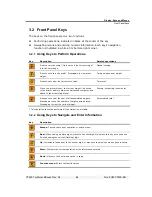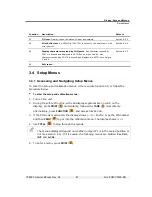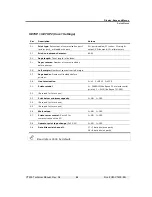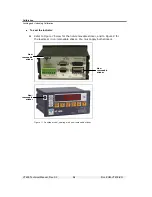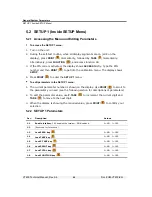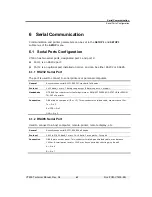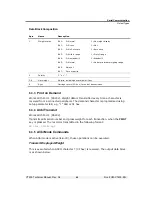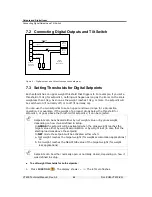
Calibration
Electronic Calibration (E-CAL)
VT400 Technical Manual, Rev. A5
35
Doc
#
UM-VT400-EN
4.2.1
Calculating Calibration Values
Consider the following example. A scale has maximum capacity 30/60kg,
e=0.010/0.020kg, with 4 load cells, each of rated capacity 50kg (2mV) and dead load
1.940kg. The load cell data, as noted in the manufacturer data sheet, is shown in the
following table.
Load cell
Output at 50kg
Zero balance
L/C1 1.9793mV
0.0257mV
L/C2 1.9392mV
0.0276mV
L/C3 1.9577mV
0.0553mV
L/C4 1.9640mV
-0.0022mV
To calculate the dead-load and span calibration values:
1. Calculate an average of the load cells’ rated output. In the example above, this
equals (1.9793+1.9392+1.9577+1.9640)/4=1.9600mV.
2. Calculate the combined output of the load cells when the scale is at maximum
capacity. In the example above, this equals 1.9600x60/4x50=
0.5880 mV/V
. This
is the
span calibration value
.
3. Calculate an average of the load cells’ zero balance. In the example above, this
equals [0.0257+0.0276+0.0553+(-0.0022)]/4=0.0266mV.
4. Calculate the scale dead-load. In the example above, this equals
1.9600mV*[1.940Kg/(4*50Kg)]=0.0190mV.
5. Calculate the overall dead-load by adding together the load cell zero balance and
the scale dead-load (calculated in step 2). In the example above, this equals
0.0266+0.0190=
0.0456mV
. This is the
dead-load calibration value
.
4.2.2
Setting Zero Calibration (Dead-Load) Value
To set the zero calibration value electronically:
1. Enter the setup menus and use
TOTAL
(
) to scroll to the
CAL
menu. Press
( )
to enter the menu.
2. Press
( ) to enter the
E-CAL
menu.
3. Press
( ) to select the
Zero
option (zero calibration).
4. Enter the overall mV of the dead-load (see section
4.2.1 to learn how to calculate
it). Use
P.TARE
(
) to edit the current digit and
TARE
( ) to move to the next
digit.
5.
Press
( ) to record the zero calibration value. The display shows the
corresponding weight.



